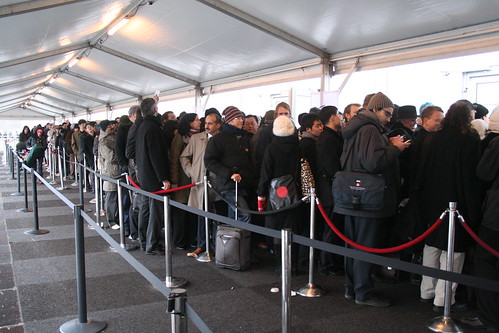COP15 Postmortem: Part I the UNFCCC process
It has taken this observer a few days (critically complemented by well overdue restful nights) to fairly assess the results of the Copenhagen fortnight. This delayed consideration is in part due to access, an issue I will raise first, not in order of importance, but due to the immediate impacts on my final days at the COP.
The UNFCCC Secretariat and COP host city have historically made Herculean efforts to ensure proceedings are transparent and accessible to all that have a legitimate stake in the process. Indeed the first week of COP15 was no exception to this admirable trend, even as Copenhagen’s Bella Center swelled under the strain of a record number of participants. However, burgeoning crowds of new arrivals in the COP’s second week confounded UNFCCC computer systems, strained already taxed logistics, and quickly exceeded the building’s occupancy limit. These capacity issues were further compounded as scores of high-level ministers and accompanying entourages streamed in for the latter week’s push. Finally, access went from difficult to impossible as security was heightened in the closing days of the COP to accommodate the almost 120 heads of state assembled to throw their weight behind the negotiations.
The sheer logistical challenge of accommodating so many eager participants marked an inflection point in the UNFCCC process in a number of respects, with COP15 representing the first significant limitation of access to civil society. While the organizers’ decision to pare down the ranks of admitted NGO observers from more than 10,000 to 7,000 and finally to just 300 sparked visceral outrage, an alternate emotionally-removed perspective would be right to note that these were not arbitrary restrictions and by many measures the action required to manage this heightened interest speaks to the ascendency of climate change from an obscure technical conversation to a top tier pressing issue of our day. Nevertheless, the fact that an unwieldy 45,000+ registered for the COP – an awkward number for any venue outside of a football stadium – inexorably leads to a conclusion that the UNFCCC COP process requires fundamental retooling.
Indeed, in the wake of spoiled expectations having very little to do with civil society’s harrumphing, some commentators are loudly arguing that the UNFCCC process is not just broken, but unfixable. Highlighting UN formality and decorum with specific reference to the fora’s fixation on unanimity and in turn the equal power it de facto grants nations large and small, these voices suggest diversity ultimately undermines expediency. Pointing to the limited number of participants (five named with 28 total signatories) in the summit’s vague but incrementally ambitious gesture towards an international agreement, the U.S. brokered Copenhagen Accord, the value of alternative venues for large emitters has again risen to the fore. In fact one such meeting has already been proposed by French President Nicholas Sarkozy in advance of the UNFCCC’s summer intersessional (tentatively the body’s next scheduled meeting).
Debate over the UNFCCC process will undoubtedly pick up in the New Year, but for now the preliminary noise being made on the topic provides an interesting backdrop for the subject of the part II of this post: the actual progress made at the COP.

Crowds at the Bella Center queue outside the COP in long lines, often for hours at a time. photo courtesy of: http://www.flickr.com/photos/aussmc/4187971144/

The focus on a smaller number of countries concerned with the bulk of the emissions seems so sensible; it seems obvious that they should have settled their differences before any convening of a larger group. Why was this not the case in the first place?
Fine blog! An amazing surprise to me was the huge number of civil society’s organisations of every stripe pushing for a place in the Bella Center. I guess many of those organisations were a mere rubber stamp in the international constellation of environmental groups that were jostling to get some publicity to escape from nothingness. Probably they will be present in every major UNFCCC meeting, which forecasts surmounting phenomenal organisational hurdles to accomodate them all. Just for fun, really.
Ian and Hector:
Thank you kindly for the comments. Please accept my apologies for being tardy in responding over the holiday.
@Ian
I think your comment hits squarely on the importance of having large emitters on the same page going into full-scale negotiations. There has long been a push for engagement at this level in a variety of fora outside of the UNFCCC, with mixed results. The value of such meetings, however, must be balanced to ensure that smaller and developing nations are not systemically excluded (or even perceive that they are being marginalized).
I would suggest that both issues underscore the difficulty of managing collective action with so much at stake, from the parochial politics of sharing mitigation costs to the ethical concerns of climate impacts.
@Hector
Indeed I think everyone was surprised at the sheer scale of civil society’s involvement in Copenhagen (the UNFCCC secretariat and Danish government included!). Your cynicism with respect to the legitimate need for so many NGOs to participate in the COP is well founded, particularly amidst the larger trend amongst NGOs to tack on climate change programming to “stay relevant,” in effect leveraging the notoriety of the COP for what could be viewed as self-promotion. Playing devil’s advocate, I think we’d all welcome increased *substantive* engagement on climate change from all parties (including the diverse interests represented by civil society). As your comment suggests we’re perhaps not quite there yet, but the UNFCCC process and its spirit of openness has fostered increased activity …though, as you say, there may have to be some retooling of the technical logistics if we’re to continue to welcome so many under the COP tent.